07 July 2016
Hampton Court Flower Show
Tapping into the zeitgeist.
by Lynda Goetz
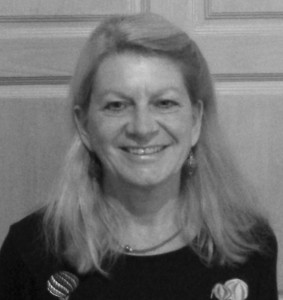 Space and grass. Those were my first impressions of the Hampton Court Flower Show in 1994. After many wonderful but decidedly crowded visits to Chelsea, those two elements made a lasting impression. On Tuesday those two factors impressed me yet again as I made my way around the 25 acre site on a day which turned out to be just about perfect in terms of weather. The rain didn’t simply hold off, the clouds turned from grey to white and fluffy, the sky was blue and the sun shone – without being so hot that one needed to seek the shade of the avenue of lime trees by Long Water stretching out in front of magnificent Hampton Court itself.
Space and grass. Those were my first impressions of the Hampton Court Flower Show in 1994. After many wonderful but decidedly crowded visits to Chelsea, those two elements made a lasting impression. On Tuesday those two factors impressed me yet again as I made my way around the 25 acre site on a day which turned out to be just about perfect in terms of weather. The rain didn’t simply hold off, the clouds turned from grey to white and fluffy, the sky was blue and the sun shone – without being so hot that one needed to seek the shade of the avenue of lime trees by Long Water stretching out in front of magnificent Hampton Court itself.
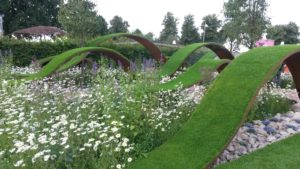 Since the RHS got involved in 1993 this show has gone from strength to strength, and whilst Chelsea is undeniably the most prestigious, Hampton Court has a different appeal of its own. Part of that appeal is most definitely the space and the grass. Unless it is very wet (when the appeal of the grass is much reduced of course), the fact that the public is not constrained by the paths and walkways but is free to meander and wander amongst the gardens and trade stands, makes for a very relaxed and English sort of day out. The gardens are rarely as striking as those at Chelsea, and it is clear that the investment in most of them is nothing like as substantial; for many people, however, that is clearly reassuring as a large number of the gardens are small and visitors can relate to displays which they can envisage being able to replicate. It can also be a springboard for younger or novice designers, as well a serious PR exercise for a variety of charities who use this show in a way they cannot use Chelsea. Charities as diverse as Bowel Disease UK, UNHCR (the UN Refugee Agency), Southend Youth Offending Service and Mind, to name but a few, employ relatively unknown or lesser-known designers to promote their causes in a way that larger businesses or companies do with celebrity designers at Chelsea.
Since the RHS got involved in 1993 this show has gone from strength to strength, and whilst Chelsea is undeniably the most prestigious, Hampton Court has a different appeal of its own. Part of that appeal is most definitely the space and the grass. Unless it is very wet (when the appeal of the grass is much reduced of course), the fact that the public is not constrained by the paths and walkways but is free to meander and wander amongst the gardens and trade stands, makes for a very relaxed and English sort of day out. The gardens are rarely as striking as those at Chelsea, and it is clear that the investment in most of them is nothing like as substantial; for many people, however, that is clearly reassuring as a large number of the gardens are small and visitors can relate to displays which they can envisage being able to replicate. It can also be a springboard for younger or novice designers, as well a serious PR exercise for a variety of charities who use this show in a way they cannot use Chelsea. Charities as diverse as Bowel Disease UK, UNHCR (the UN Refugee Agency), Southend Youth Offending Service and Mind, to name but a few, employ relatively unknown or lesser-known designers to promote their causes in a way that larger businesses or companies do with celebrity designers at Chelsea.
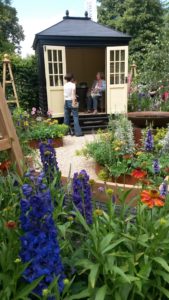 The other way in which Hampton Court differs so dramatically from Chelsea is the fact that, because of the space available, nurseries can actually sell here in a way that is not possible in central London. At Hampton Court the ubiquitous plastic boxes on wheels are almost as colourful as the plants – although rather less tasteful. The boxes, although undoubtedly a useful means of transporting purchases, can also be incredibly annoying to other show-goers. So many people seem to forget they are trailing these shopping trolleys behind them and (particularly in areas like the Floral Marquee or the Festival of Roses tent) can end up obstructing others or simply clipping their heels as they blithely haul their booty around.
The other way in which Hampton Court differs so dramatically from Chelsea is the fact that, because of the space available, nurseries can actually sell here in a way that is not possible in central London. At Hampton Court the ubiquitous plastic boxes on wheels are almost as colourful as the plants – although rather less tasteful. The boxes, although undoubtedly a useful means of transporting purchases, can also be incredibly annoying to other show-goers. So many people seem to forget they are trailing these shopping trolleys behind them and (particularly in areas like the Floral Marquee or the Festival of Roses tent) can end up obstructing others or simply clipping their heels as they blithely haul their booty around.
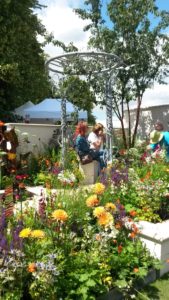 It is much harder here than at Chelsea to feel one has ‘done’ the whole of the show and I certainly always have the feeling there are things I have missed. It hardly matters though, as apart from space and grass one absorbs the atmosphere and trends of the gardening world. In the Conceptual Gardens one can try and guess what Mind are trying to say with their rocky island covered in dark and gloomy conifers cut off from grasses and wild flowers by a black moat; or what UNHCR are illustrating with their island which, by contrast, is an appealing oasis surrounded by barbed wire fences, broken toys and lifejackets; or indeed what all the greenhouses with different interiors could be saying about our atmosphere and planet. In other gardens, plants are grown for medicinal purposes or to encourage wildlife, and in yet others we are encouraged to see the benefits of relaxation amidst the flowers which strangely this year all seem to be combinations of purple, orange and yellow. How is it that each year, seemingly in some unspoken pact, all the designers seem to have honed in on one particular plant or colour combination? In the same way as names seem suddenly to be in vogue, plants and colours enter some form of universal consciousness and are this year’s ‘must have’.
It is much harder here than at Chelsea to feel one has ‘done’ the whole of the show and I certainly always have the feeling there are things I have missed. It hardly matters though, as apart from space and grass one absorbs the atmosphere and trends of the gardening world. In the Conceptual Gardens one can try and guess what Mind are trying to say with their rocky island covered in dark and gloomy conifers cut off from grasses and wild flowers by a black moat; or what UNHCR are illustrating with their island which, by contrast, is an appealing oasis surrounded by barbed wire fences, broken toys and lifejackets; or indeed what all the greenhouses with different interiors could be saying about our atmosphere and planet. In other gardens, plants are grown for medicinal purposes or to encourage wildlife, and in yet others we are encouraged to see the benefits of relaxation amidst the flowers which strangely this year all seem to be combinations of purple, orange and yellow. How is it that each year, seemingly in some unspoken pact, all the designers seem to have honed in on one particular plant or colour combination? In the same way as names seem suddenly to be in vogue, plants and colours enter some form of universal consciousness and are this year’s ‘must have’.
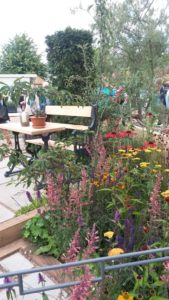 In 1994 the Hampton Court flower show was, according to Wikipedia, declared the best outdoor event of the year (although by whom they do not bother to mention). In 2016 there are so many more outdoor events, shows and festivals that this particular one has a lot more competition than it did back then, but it continues to generate massive support and enthusiasm and to engage visitors with its space, environment and visions of greater understanding between people and countries expressed in plants, gardens and palettes of annually changing colours. Will my garden be out of date by next year or will I have managed to lock into the 2017 zeitgeist and have changed purple and orange for what, I wonder? Could we possibly be back to red, white and blue (not for 1916 and the Somme as this year) or is it more likely to be blue and yellow – to emphasise our continuing links to Europe?
In 1994 the Hampton Court flower show was, according to Wikipedia, declared the best outdoor event of the year (although by whom they do not bother to mention). In 2016 there are so many more outdoor events, shows and festivals that this particular one has a lot more competition than it did back then, but it continues to generate massive support and enthusiasm and to engage visitors with its space, environment and visions of greater understanding between people and countries expressed in plants, gardens and palettes of annually changing colours. Will my garden be out of date by next year or will I have managed to lock into the 2017 zeitgeist and have changed purple and orange for what, I wonder? Could we possibly be back to red, white and blue (not for 1916 and the Somme as this year) or is it more likely to be blue and yellow – to emphasise our continuing links to Europe?
If you enjoyed this article please share it using the buttons above.
Please click here if you would like a weekly email on publication of the Shaw Sheet

